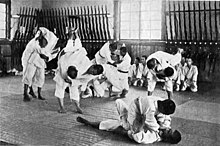Ju-Jitsu

Jujutsu training at an agricultural school in Japan around 1920
|
|
| Also known as | Jiu-Jitsu, Jiujitsu, Ju-Jitsu, Jujitsu |
|---|---|
| Focus | Grappling |
| Country of origin |
|
| Famous practitioners | Takeda Sōkaku, Seishiro Okazaki, Jigoro Kano, Wally Jay, Gokor Chivichyan, Gene LeBell, Lee Hasdell, Carlos Newton, Benny Urquidez, Tim Kennedy, Shonie Carter, Bill Underwood, Harold Howard, Michel van Rijt, Moshé Feldenkrais, Dong Jin Kim, Mikinosuke Kawaishi, Jean-Yves Thériault, Alexis Davis, Stephen Thompson, Serge Mol, Mikhail Zayats, Matt Larsen |
| Parenthood | Various Japanese martial arts |
| Descendant arts | Judo, Sambo, Brazilian jiu-jitsu (via Judo), Aikido, Hapkido, Bartitsu, Catch Wrestling, German ju-jutsu |
| Olympic sport | Judo |
Jujutsu (/dʒuːˈdʒuːtsuː/ joo-JOOT-soo; Japanese: 柔術, jūjutsu ![]() listen ) is a Japanese martial art and a method of close combat for defeating an armed and armored opponent in which one uses no weapon or only a short weapon.
listen ) is a Japanese martial art and a method of close combat for defeating an armed and armored opponent in which one uses no weapon or only a short weapon.
"" can be translated to mean "gentle, soft, supple, flexible, pliable, or yielding." "" can be translated to mean "art" or "technique" and represents manipulating the opponent's force against himself rather than confronting it with one's own force. Jujutsu developed to combat the samurai of feudal Japan as a method for defeating an armed and armored opponent in which one uses no weapon, or only a short weapon. Because striking against an armored opponent proved ineffective, practitioners learned that the most efficient methods for neutralizing an enemy took the form of pins, joint locks, and throws. These techniques were developed around the principle of using an attacker's energy against him, rather than directly opposing it.
...
Wikipedia
